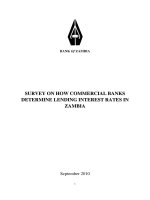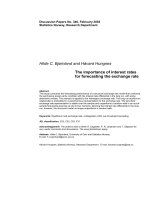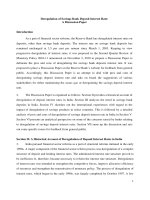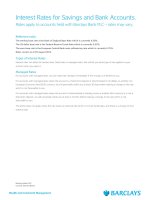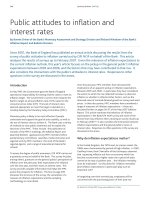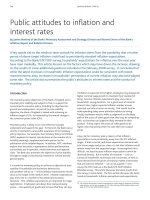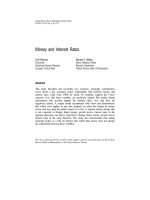CALCULATING INTEREST RATES: A READING PREPARED doc
Bạn đang xem bản rút gọn của tài liệu. Xem và tải ngay bản đầy đủ của tài liệu tại đây (107.95 KB, 6 trang )
Calculating interest rates
A reading prepared by Pamela Peterson Drake
O U T L I N E
1. Introduction
2. Annual percentage rate
3. Effective annual rate
1. Introduction
The basis of the time value of money is that an investor is compensated for the time value of money
and risk. Situations arise often in which we wish to determine the interest rate that is implied from
an advertised, or stated rate. There are also cases in which we wish to determine the rate of interest
implied from a set of payments in a loan arrangement.
2. The annual percentage rate
A common problem in finance is comparing alternative financing or investment opportunities when
the interest rates are specified in a way that makes it difficult to compare terms. One lending source
may offer terms that specify 9
1
/
4
percent annual interest with interest compounded annually,
whereas another lending source may offer terms of 9 percent interest with interest compounded
continuously. How do you begin to compare these rates to determine which is a lower cost of
borrowing? Ideally, we would like to translate these interest rates into some comparable form.
One obvious way to represent rates stated in various time intervals on a common basis is to express
them in the same unit of time so we annualize them. The
annualized rate
is the product of the
stated rate of interest per compounding period and the number of compounding periods in a year.
Let i be the rate of interest per period and let n be the number of compounding periods in a year.
The annualized rate, also referred to as the
nominal interest rate
or the
annual percentage
rate (APR)
, is
APR = i x n
where i is the rate per compounding period and n is the number of compound periods in a year.
The Truth in Lending Act requires lenders to disclose the annual percentage rate on consumer loans.
1
As you will see, however, the annual percentage rate ignores compounding and therefore
1
15 U.S.C. §§1601-1666j; Federal Reserve System Regulation Z, 1968.
Calculating interest rates, a reading prepared by Pamela Peterson Drake 1
understates the true cost of borrowing. Also, as pointed out in the Report to Congress by the Board
of Governors of the Federal Reserve System,
Finance Charges for Consumer Credit under the Truth in
Lending Act
, the APR does not consider some other costs associated with lending transactions.
The
Truth in Savings Act (Federal Reserve System Regulation DD, 1991) requires institutions to
provide the
annual percentage yield (APY)
for savings accounts, which is a rate that considers
the effects of compound interest. As a result of this law, consumers can compare the yields on
different savings arrangements. But this law does not apply
beyond
savings accounts.
To see how the APR works, let's consider the Lucky Break Loan Company. Lucky's loan terms are
simple: pay back the amount borrowed, plus 50 percent, in six months. Suppose you borrow $10,000
from Lucky. After six months, you must pay back the $10,000, plus $5,000. The annual percentage
rate on financing with Lucky is the interest rate per period (50 percent for six months) multiplied by
the number of compound periods in a year (two six-month periods in a year). For the Lucky Break
financing arrangement,
APR = 0.50 x 2 = 1.00 or 100 percent per year
But what if you cannot pay Lucky back after six months? Lucky will let you off this time, but you must
pay back the following at the end of the next six months:
• the $10,000 borrowed,
• the $5,000 interest from the first six months, and
• 50 percent interest on both the unpaid $10,000 and the unpaid $5,000 interest ($15,000 x
.50 = $7,500).
So, at the end of the year, knowing what is good for you, you pay off Lucky:
Amount of original loan $10,000
Interest from first six months 5,000
Interest on second six months
7,500
Total payment at end of year $22,500
It is unreasonable to assume that, after six months, Lucky would let you forget about paying interest
on the $5,000 interest from the first six months.
If
Lucky would forget about the interest on interest,
you would pay $20,000 at the end of the year $10,000 repayment of principal and $10,000 interest
which is a 100 percent interest rate.
Using the Lucky Break method of financing, you have to pay $12,500 interest to borrow $10,000 for
one year's time or else. Because you have to pay $12,500 interest to borrow $10,000 over one
year's time, you pay not 100 percent interest, but rather 125 percent interest per year:
Annual interest rate on a Lucky Break loan = $12,500 / $10,000 = 125 percent
What's going on here? It looks like the APR in the Lucky Break example ignores the compounding
(interest on interest) that takes place after the first six months.
And that's the way it is with
all
APR's: the APR ignores the effect of compounding. And therefore this
rate understates the true annual rate of interest if interest is compounded at any time prior to the
end of the year. Nevertheless, APR is an acceptable method of disclosing interest on many lending
arrangements since it is easy to understand and simple to compute. However, because it ignores
compounding, it is not the best way to convert interest rates to a common basis.
Calculating interest rates, a reading prepared by Pamela Peterson Drake 2
3. Effective annual rate
Another way of converting stated interest rates to a common basis is the effective rate of interest.
The
effective annual rate (EAR)
is the
true
economic return for a given time period it takes into
account the compounding of interest and is also referred to as the
effective rate of interest
.
Using our Lucky Break example, we see that we must pay $12,500 interest on the loan of $10,000
for one year. Effectively, we are paying 125 percent annual interest. Thus, 125 percent is the
effective annual rate of interest.
In this example, we can easily work through the calculation of interest and interest on interest. But
for situations where interest is compounded more frequently we need a direct way to calculate the
effective annual rate. We can calculate it by resorting once again to our basic valuation equation:
FV = PV (1 + i)
n
Next, we consider that a return is the change in the value of an investment over a period and an
annual return is the change in value over a year.
Suppose you invest $100 today in an investment that pays 6 percent annual interest, but interest is
compounded every four months. This means that 2 percent is paid every four months. After four
months, you have $100 (1.2) = $102, after eight months you have $102 (1.02) = $104.04, and after
one year you have $104.04 (1.02) = 106.1208, or, $100 (1.02)
3
= $106.1208
The effective annual rate of interest (EAR) is $6.1208 paid on $100, or 6.1208 percent. We can
arrive at that interest by rearranging the basic valuation formula based on a one year period:
$106.1208 = $100 (1 + 0.02)
3
$106.1208/$100 = (1 + 0.02)
3
1.061208 = (1 + 0.02)
3
EAR = (1 + 0.02)
3
– 1 = 0.061208 or 6.1208 percent
In more general terms, the effective interest rate, EAR, is:
EAR = (1 + i)
n
1
The
effective rate of interest
(a.k.a. effective annual rate or EAR) is therefore an annual rate that
takes into consideration any compounding that occurs during the year.
Let's look how the EAR is affected by the compounding. Suppose that the Safe Savings and Loan
promises to pay 6 percent interest on accounts, compounded annually. Because interest is paid once,
at the end of the year, the effective annual return, EAR, is 6 percent. If the 6 percent interest is paid
on a semi-annual basis 3 percent every six months the effective annual return is larger than 6
percent because interest is earned on the 3 percent interest earned at the end of the first six months.
In this case, to calculate the EAR, the interest rate per compounding period six months is 0.03
(that is, 0.06 / 2) and the number of compounding periods in an annual period is 2:
EAR = (1 + i)
n
- 1
EAR = (1 + 0.03)
2
- 1 = 1.0609 - 1 = 0.0609 or 6.09%.
Extending this example to the case of quarterly compounding with a nominal interest rate of 6
percent we first calculate the interest rate per period, r, and the number of compounding periods in a
year, n:
i = 0.06 / 4 = 0.015 per quarter, and
n = 12 months / 3 months = 4 quarters in a year.
The EAR is:
Calculating interest rates, a reading prepared by Pamela Peterson Drake 3
EAR = (1 + 0.015)
4
- 1 = 1.0614 - 1 = 0.0614 or 6.14%
Suppose there are two banks: Bank A, paying 12 percent interest compounded semi-annually, and
Bank B: paying 11.9 percent interest compounded monthly. Which bank offers you the best return on
your money? Comparing APR's, Bank A provides the higher return. But what about compound
interest? The EAR's for each account are calculated as:
Bank A:
EAR = (1 + 0.12/2)
2
- 1 = (1 + 0.06)
2
= 1.1236 - 1 = 0.1236 or 12.36%
Bank B:
EAR = (1 + 0.119/12)
12
- 1 = (1 + 0.0099)
12
- 1 = 1.1257 - 1 = 0.1257 or 12.57%
Bank B offers the better return on your money, even though it advertises a lower APR. If you deposit
$1,000 in Bank A for one year, you will have $1,123.60 at the end of the year. If you deposit $1,000
in Bank B for one year, you will have $1,125.70 at the end of the year, providing the better return on
your savings.
PayDay Loans – The fast and expensive way to borrow
A payday loan is a short-term loan with very high interest rates. In a typical payday loan, if you want to borrow
$100 you write a check for $125. The lender holds on to your check during the loan period. At the end of the
loan period, usually 10-14 days, the lender deposits your check. If you want to extend your loan, you pay the
minimum of $25 cash and then enter into a new contract to pay. If you do not pay off the loan or pay the fee to
roll over the loan, the lender will deposit your check and you risk being charged with writing bad checks.
What is the APR for this payday loan?
APR = 0.25 (365/14) = 651.79%
What is the EAR for this payday loan?
EAR = (1 + 0.25)
365/14
-1 = 3,351.86%
The regulations pertaining to payday loans varies among states, but most states allow very generous lending
terms – generous, that is, to the lenders. [For a list of state limits on payday loans, see the
Bankrate Monitor.]
Calculating interest rates, a reading prepared by Pamela Peterson Drake 4
A. Continuous compounding
The extreme frequency of compounding is continuous compounding.
Continuous compounding
is
when interest is compounded at the smallest
possible increment of time. In continuous
compounding, the rate per period becomes
extremely small:
Example 1: Comparing effective rates
Problem
Which of the following terms represent the lowest cost of
credit on an effective annual interest rate basis?
i = nominal interest rate / ∞
And the number of compounding periods in a
year, n, is infinite. As the rate of interest, i,
gets smaller and the number of compounding
periods approaches infinity, the EAR is:
1. 10% APR, interest compounded semi-annually.
2. 9.75% APR, interest compounded continuously.
3. 10.5% APR, interest compounded annually.
4. 9.8% APR, interest compounded quarterly.
Solution
EAR = (1 +
APR
/
n
)
n
- 1
d
where APR is the annual percentage rate.
What does all this mean? It means that the
interest rate per period approaches 0 and the
number of compounding periods approaches
infinity at the same time! For a given
nominal interest rate under continuous
compounding, it can be shown that:
1. EAR = (1 + 0.05)
2
- 1 = 10.25%
2. EAR = e
0.0975
- 1 = 10.241%
3. EAR = 10.5%
4. EAR = (1 + 0.0245)
4
- 1 = 10.166%
Exhibit 1: Effective Annual Rates of
Interest Equivalent to an Annual
Percentage Rate of 6 percent
EAR = e
APR
- 1
For the stated 6 percent annual interest rate
compounded continuously, the EAR is:
Frequency of
compounding per
year
Calculation EAR
EAR = e
0.06
- 1 = 1.0618 - 1 EAR = 0.0618 or
6.18 percent .
(1 + 0.060)
1
- 1 6.00% Annual
(1 + 0.030)
2
- 1 6.09 Semi-annual
(1 + 0.015)
4
- 1 6.14
The relation between the frequency of
compounding, for a given stated rate, and the
effective annual rate of interest for this example
indicates that the greater the frequency of
compounding, the greater the EAR.
Quarterly
Continuous e
0.06
- 1 6.18
B. Calculator and spreadsheet applications
Financial calculators typically have a built-in program to help you go from APRs to EARs and vice
versa. For example, using the financial calculator, we can
calculate the EAR that corresponds to a 10 percent APR with
quarterly compounding:
2
The result is an EAR of 10.3813
percent.
TI 83/84
Using TVM Solver
HP10B
EFF(10,4)
ENTER
10 NOM%
4 P/Y
EFF%
2
Because these calculations require changing the payments per period settings (i.e., P/YR) in some
calculator models, be sure to change these back to one payment per period following the calculations
otherwise all subsequent financial calculations may be incorrect.
Calculating interest rates, a reading prepared by Pamela Peterson Drake 5
In a similar manner, we can calculate the nominal (i.e., APR) rate that corresponds to a given EAR.
Suppose we want to find the nominal rate with quarterly
compounding that is equivalent to an effective rate of 10
percent. The equivalent APR is 9.6455 percent. In other
words, if a lender charges 9.6455 percent APR, it will earn,
effectively, 10 percent on the loan.
Continuous compounding calculations cannot be done using the built in finance programs. However,
most calculators whether financial or not have a program that allows you to perform calculations
using e, the base of natural logarithms. The EAR corresponding to an APR with continuous
compounding is 10.52 percent, which you can calculate as e
0.1
-1.
TI 83/84
Using TVM Solver
HP10B
NOM(10,4)
ENTER
10 EFF%
4 P/Y
NOM%
TI 83/84
Spreadsheet functions can also be used to calculate either the
nominal rate or the effective rate. In Microsoft Excel®, for
example, you can calculate the effective rate that equivalent to
an APR of 10 percent with monthly compounding as:
HP10B
e
x
(.1)-1 ENTER .1
e
x
– 1 =
=EFFECT(.10,12),
which produces an answer of 10.471 percent.
Similarly, finding the nominal rate with monthly compounding that is equivalent to an EAR of 10
percent,
=NOMINAL(.10,12),
which produces an answer of 9.569 percent.
Calculating interest rates, a reading prepared by Pamela Peterson Drake 6


